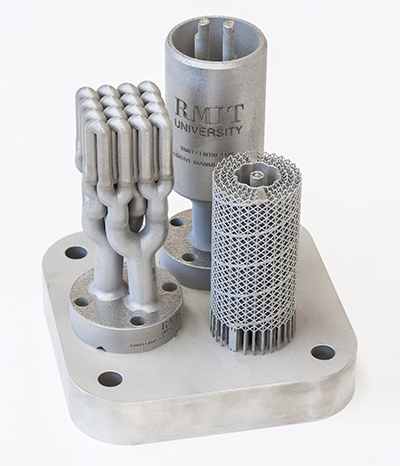| Sep 07, 2021 |
Next gen 3D printed catalysts to propel hypersonic flight
|
|
(Nanowerk News) Ultra-efficient 3D printed catalysts could help solve the challenge of overheating in hypersonic aircraft and offer a revolutionary solution to thermal management across countless industries.
|
|
Developed by researchers at RMIT University, the highly versatile catalysts are cost-effective to make and simple to scale.
|
|
The team’s lab demonstrations show the 3D printed catalysts could potentially be used to power hypersonic flight while simultaneously cooling the system.
|
|
The research is published in the Royal Society of Chemistry journal, Chemical Communications ("Zeolites on 3D-Printed Open Metal Framework Structure: Metal migration into zeolite promoted catalytic cracking of endothermic fuels for flight vehicles").
|
 |
| A range of experimental designs for the 3D-printed catalysts. (Image: RMIT University)
|
|
Lead researcher Dr Selvakannan Periasamy said their work tackled one of the biggest challenges in the development of hypersonic aircraft: controlling the incredible heat that builds up when planes fly at more than five times the speed of sound.
|
|
“Our lab tests show the 3D printed catalysts we’ve developed have great promise for fuelling the future of hypersonic flight,” Periasamy said.
|
|
“Powerful and efficient, they offer an exciting potential solution for thermal management in aviation - and beyond.
|
|
“With further development, we hope this new generation of ultra-efficient 3D printed catalysts could be used to transform any industrial process where overheating is an ever-present challenge.”
|
Need for speed
|
|
Only a few experimental planes have reached hypersonic speed (defined as above Mach 5 - over 6,100km an hour or 1.7km per second).
|
|
In theory, a hypersonic aircraft could travel from London to Sydney in four hours but many challenges remain in the development of hypersonic air travel, such as the extreme heat levels.
|
|
First author and PhD researcher Roxanne Hubesch said using fuel as a coolant was one of the most promising experimental approaches to the overheating problem.
|
|
“Fuels that can absorb heat while powering an aircraft are a key focus for scientists, but this idea relies on heat-consuming chemical reactions that need highly efficient catalysts,” Hubesch said.
|
|
“Additionally, the heat exchangers where the fuel comes in contact with the catalysts must be as small as possible, because of the tight volume and weight constraints in hypersonic aircraft.”
|
|
To make the new catalysts, the team 3D printed tiny heat exchangers made of metal alloys and coated them with synthetic minerals known as zeolites.
|
|
The researchers replicated at lab scale the extreme temperatures and pressures experienced by the fuel at hypersonic speeds, to test the functionality of their design.
|
Miniature chemical reactors
|
|
When the 3D printed structures heat up, some of the metal moves into the zeolite framework– a process crucial to the unprecedented efficiency of the new catalysts.
|
|
“Our 3D printed catalysts are like miniature chemical reactors and what makes them so incredibly effective is that mix of metal and synthetic minerals,” Hubesch said.
|
|
“It’s an exciting new direction for catalysis, but we need more research to fully understand this process and identify the best combination of metal alloys for the greatest impact.”
|
|
The next steps for the research team from RMIT’s Centre for Advanced Materials and Industrial Chemistry (CAMIC) include optimising the 3D printed catalysts by studying them with X-ray synchrotron techniques and other in-depth analysis methods.
|
|
The researchers also hope to extend the potential applications of the work into air pollution control for vehicles and miniature devices to improve indoor air quality - especially important in managing airborne respiratory viruses like COVID-19.
|
|
CAMIC Director, Distinguished Professor Suresh Bhargava, said the trillion-dollar chemical industry was largely based on old catalytic technology.
|
|
“This third generation of catalysis can be linked with 3D printing to create new complex designs that were previously not possible,” Bhargava said.
|
|
“Our new 3D printed catalysts represent a radical new approach that has real potential to revolutionise the future of catalysis around the world.”
|
|
The 3D printed catalysts were produced using Laser Powder Bed Fusion (L-PBF) technology in the Digital Manufacturing Facility, part of RMIT’s Advanced Manufacturing Precinct.
|

